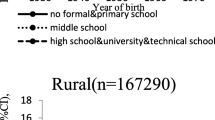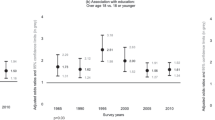Abstract
We examined the influence of duration of exclusive breastfeeding (DEBF) for a mother’s earlier children on the DEBF for her later children among multiparous women from the 2002 National Survey of Family Growth. DEBF was categorized as: never breastfed (NBF) (referent); not exclusively breastfed or exclusively breastfed for <4 months (EBF < 4); and exclusively breastfed for ≥4 months (EBF ≥ 4). We examined DEBF using weighted percentages and odds ratios (OR) with 95% confidence intervals (CI) from multinomial logistic regression models, adjusting for maternal factors. About 70% of multiparous women (n = 2,149) repeated the duration of exclusive breastfeeding of their first child for their second child; 14% of women repeated EBF ≥ 4. Among multiparous women, the adjusted odds ratio for EBF ≥ 4 for second children was 7.2 (95% CI = 4.0–12.9) when first children were EBF < 4 and 90.7 (95% CI = 45.4–181.4) when first children were EBF ≥ 4, relative to NBF first children. In analyses where DEBF of third children was the outcome, odds of EBF ≥ 4 were more strongly influenced by DEBF of second children while the impact of DEBF of first children was not as strong. Older maternal age and being married were related to an increased DEBF. Being married at second birth predicted a change from NBF for first children to EBF ≥ 4 for second children (OR = 6.2, 95% CI = 2.7–14.2). In conclusion, mothers generally repeated the DEBF of their previous child. For third children, DEBF of the second child was more likely to be repeated than that of the first child.
Similar content being viewed by others
References
Gartner, L. M., Morton, J., Lawrence, R. A., et al. (2005). Breastfeeding and the use of human milk. Pediatrics, 115, 496–506.
Thygarajan, A., & Burks, A. W. (2008). American Academy of Pediatrics recommendations on the effects of early nutritional interventions on the development of atopic disease. Current Opinion in Pediatrics, 20, 698–702.
Anderson, J., Malley, K., & Snell, R. (2009). Is 6 months still the best for exclusive breastfeeding and introduction of solids? A literature review with consideration to the risk of the development of allergies. Breastfeed Rev, 17, 23–31.
Centers for Disease Control and Prevention. (2010). Breastfeeding among US children born 1999–2006. http://www.cdc.gov/BREASTFEEDING/DATA/NIS_data/index.htm. [Date of Access: January, 25, 2010].
Thulier, D., & Mercer, J. (2009). Variables associated with breastfeeding duration. Journal of Obstetric, Gynecologic, and Neonatal Nursing, 38, 259–268.
Hornell, A., Aarts, C., Kylberg, E., et al. (1999). Breastfeeding patterns in exclusively breastfed infants: a longitudinal prospective study in Uppsala, Sweden. Acta Paediatrica, 88, 203–211.
Nagy, E., Orvos, H., Pal, A., et al. (2001). Breastfeeding duration and previous breastfeeding experience. Acta Paediatrica, 90, 51–56.
Kruse, L., Denk, C. E., Feldman-Winter, L., et al. (2006). Longitudinal patterns of breastfeeding initiation. Maternal and Child Health Journal, 10, 13–18.
Taylor, J. S., Geller, L., Risica, P. M., et al. (2008). Birth order and breastfeeding initiation: Results of a national survey. Breastfeeding Medicine, 3, 20–27.
Groves, R. M., Benson, G., Mosher, W. D., et al. (2005). Plan and operation of cycle 6 of the national survey of family growth. Vital and Health Statistics, 1, 1–86.
Hosmer, D., & Lemeshow, S. (2000). Applied logistic regression. New York: John Wiley & Sons.
Jones, D. A., West, R. R., & Newcombe, R. G. (1986). Maternal characteristics associated with the duration of breast-feeding. Midwifery, 2, 141–146.
Stremler, J., & Lovera, D. (2004). Insight from a breastfeeding peer support pilot program for husbands and fathers of Texas WIC participants. Journal of Human Lactation, 20, 417–422.
Brown, R. E. (1982). Breast-feeding and family planning: A review of the relationships between breast-feeding and family planning. American Journal of Clinical Nutrition, 35, 162–171.
Norton, M. (2005). New evidence on birth spacing: Promising findings for improving newborn, infant, child, and maternal health. International Journal of Gynaecology and Obstetrics, 89(Suppl 1), S1–S6.
Zhu, B. P., Rolfs, R. T., Nangle, B. E., et al. (1999). Effect of the interval between pregnancies on perinatal outcomes. New England Journal of Medicine, 340, 589–594.
Dougherty, D., & Luther, M. (2008). Birth to breast–a feeding care map for the NICU: Helping the extremely low birth weight infant navigate the course. Neonatal Network, 27, 371–377.
Rodriguez, N. A., Miracle, D. J., & Meier, P. P. (2005). Sharing the science on human milk feedings with mothers of very-low-birth-weight infants. Journal of Obstetric, Gynecologic, and Neonatal Nursing, 34, 109–119.
Black, R. E., Allen, L. H., Bhutta, Z. A., et al. (2008). Maternal and child undernutrition: Global and regional exposures and health consequences. Lancet, 371, 243–260.
Fewtrell, M. S., Morgan, J. B., Duggan, C., et al. (2007). Optimal duration of exclusive breastfeeding: What is the evidence to support current recommendations? American Journal of Clinical Nutrition, 85, 635S–638S.
Li, R., Scanlon, K. S., & Serdula, M. K. (2005). The validity and reliability of maternal recall of breastfeeding practice. Nutrition Reviews, 63, 103–110.
Gillespie, B., d’Arcy, H., Schwartz, K., et al. (2006). Recall of age of weaning and other breastfeeding variables. International Breastfeeding Journal, 1, 4.
Disclaimer
The findings and conclusions in this report are those of the authors and do not necessarily represent the official position of the Centers for Disease Control and Prevention, the Department of Health and Human Services, or the US Public Health Service.
Author information
Authors and Affiliations
Corresponding author
Rights and permissions
About this article
Cite this article
Phillips, G., Brett, K. & Mendola, P. Previous Breastfeeding Practices and Duration of Exclusive Breastfeeding in the United States. Matern Child Health J 15, 1210–1216 (2011). https://doi.org/10.1007/s10995-010-0694-4
Published:
Issue Date:
DOI: https://doi.org/10.1007/s10995-010-0694-4




